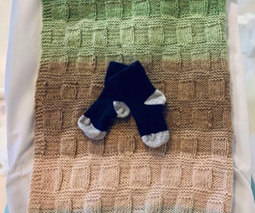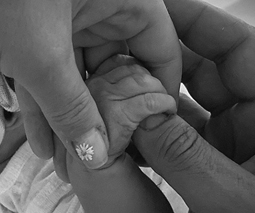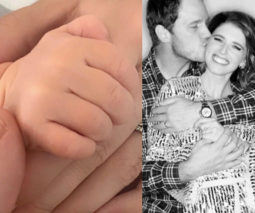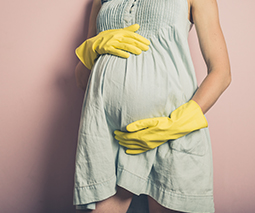When labour doesn’t go smoothly: Birth hiccups you should be prepared for

Despite our best-laid plans, babies have a way of coming into the world whatever way they need to. Being aware of the common turns of events that can happen during labour and birth can allow us to be better prepared, should the need arise.
Hannah Dahlen, a Professor of Nursing and Midwifery at Western Sydney University, and a practicing midwife, shares common concerns people have around birth.
Listen to Hannah Dahlen on Feed Play Love:
What happens if your water breaks early?
You may not realise that your baby breathes in the amniotic fluid that surrounds him, and this is crucial in helping his lungs and body develop. “The baby’s breathing … getting water into its lungs and it’s constantly moving its body,” says Hannah. “It’s exercising. So by not having a lot of water, things like lungs won’t develop as well.”
If your water breaks before 37 weeks that’s called pre-term rupture of membranes and it’s usually due to either an infection, or the baby’s simply ready to be born. If it’s the latter, Hannah says, “We have to respect that … so the first thing that we would do, is always say, ‘come in and get checked out’.”
“The concern about any water breaking, is that once you’ve broken that seal, your risk of infection increases. So [with] a very little baby, we would probably keep a woman in and monitor her closely.”
If your water breaks after 37 weeks, Hannah says, “That’s not a big deal. As long as baby’s well, mum’s well: the baby will still be pretty okay.”
If your water breaks after 37 weeks, but labour hasn’t naturally started after 18 or 24 hours, induction will be recommended to reduce the risk of infection.
How long is ‘too long’ to be in labour?
According to Hannah, our old beliefs about dilatation (the opening of the cervix) and labour, have been turned on their head recently. It used to be thought that dilation progressed at one centimetre an hour. However, World Health Organisation have announced that labour goes for longer than previously thought, and labour isn’t considered ‘established’ until the cervix is about five centimetres dilated.
Hannah says the textbooks will say that labour takes, “On average 12 hours for the first baby … well, I’m yet to meet this average woman because … it can be one hour. It can be 36, 37 hours … what’s important is how’s the mum, and how’s the baby, and what does [the mum] want? Does she want to keep going? Is she managing okay? Is the baby coping?”
“We’ve now got some evidence that labour is actually really important for switching on your genes to have a healthy response … we’re now actually seeing some evidence of people who have very, very quick labours don’t have the same switching-on genes to do with immunity.”

Is there an ideal position for the baby to be in during labour?
Put simply, for the smoothest possible birthing experience, you want your baby head down and in an anterior position. Hannah explains, “The way we want the baby to be down, is to be nice and tucked with his chin on his chest. So it’s really flexed in. And the reason for that, is that the back part of the head … is the smallest diameter and we all want the smallest bit to go through [first] – that’s a priority for us women.”
“If you think about a baby’s chin and mouth, it should face your bum, that’s the ideal position. We call that an anterior position. And in that position, the baby’s most likely to flex its head — the human pelvis is best designed for that position, and the baby comes out easily. But sometimes a baby goes down, facing up to the sky. Sometimes it begins facing the right way and turns during labour, and sometimes they do a little bit of having a look around, which means their neck’s no longer nicely flexed. Or they do something we call ‘asynclitic’ – and they look around. They stick their head on the side as though they’re kind of gazing off into our north, east or west. And that’s really unpleasant for women.”
However if this happens, Hannah reassures that there are things that you and the midwife can do to help the baby move into the right position. “We do know Rebozo works very well – so that’s a big scarf that the midwife will wrap around your uterus and she will actually get you to lean over, swing over, and she will start to swinging back and forth. And these things can help to shift the baby’s position. Moving around, being upright. All those things can help.”

Should we be worried about the umbilical cord being wrapped around the baby’s neck?
Before the baby is born, the umbilical cord takes the blood from the mother through to the baby and returns the waste. Hannah explains that, “The more the baby moves, the longer the cord is. So if you have a really active baby, the cord tends to be longer … baby will get itself, you know, wrapped up like a sushi. I’ve seen a baby completely wrapped up like a sushi.”
But Hannah says that many babies appear with the cord around their necks and this is perfectly normal. When this happens, the midwife will simply loop it over the baby’s head, or cut the cord once the head is out, if it’s really tight. Hannah confirms, “There’s a lot of anxiety around it … sometimes the cord is the cause of a baby dying. But the majority of the time, the cord is incredibly smart because it’s made of Wharton’s jelly. And Wharton’s jelly is basically like an airbag around the important vessels that run through it. So this airbag is surrounding that cord. So even when the baby, you know, sometimes sucks on it or squeezes it or whatever, it’s got this protective airbag around it, that most of the time keeps babies well.”

The number one thing that can cause complications at birth
“Fear is probably the greatest enemy of birth,” says Hannah. “I encourage women to really … talk about it to the to the midwife or the doctor. Get a midwife, have that journey, so you know the person who’s coming to the birth. You know the person giving you postnatal advice. Because what we know from the many, many international trials is [then] you have less intervention. You’re more satisfied … So really, we know that’s the gold standard that all women should be offered.”









